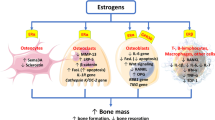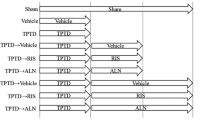Abstract
This study was carried out to investigate the effectiveness and tolerability of cyclical etidronate therapy in the prevention of bone loss occurring in early postmenopausal women who are not undergoing hormone replacement therapy (HRT). A total of 109 Caucasian women aged 45–60 years were treated with etidronate 400 mg/day or placebo for 14 days followed by calcium supplementation 500 mg/day for 77 days. Ninety-one women completed the 2 years of the study. After 2 years, the estimated difference between the two groups as regards lumbar spine bone mineral density (BMD) was 2.53% (SEM 1.07%;p=0.01); BMD of the hip and wrist were not significantly different between treatment groups. A clear reduction in bone turnover was obtained as evidenced by a significant decrease in serum alkaline phosphatase level and in urinary N-telopeptide/creatinine ratio in the etidronate group; the difference between the two groups was −12%±3.2% for serum alkaline phosphatase level (p=0.019) and −22.9%+13.7% for the urinary N-telopeptide/creatinine ratio (p=0.047). There was no statistically significant difference between the two groups in terms of the serum osteocalcin levels and urinary hydroxyproline/creatinine and calcium/creatinine ratios. Etidronate was generally well tolerated and its adverse event profile was similar to that of placebo. The results of this study indicate that cyclic etidronate therapy can prevent trabecular bone loss, with no deleterious effect on cortical bone, in the first 5 years of menopause and that it has a very high safety margin.
Similar content being viewed by others
References
Hui SL, Slemenda CW, Johnston CC. Baseline measurement of bone mass predicts fracture in white women. Ann Intern Med 1989;111:355–61.
Melton LJ, Atkinson EJ, O'Fallon WM, et al. Long-term fracture prediction by bone mineral assessed at different skeletal sites. J Bone Miner Res 1993;8:1227–33.
Cummings SR, Nevitt MC, Browner WS, et al. Risk factors for hip fractures in white women. Study of Osteoporotic Fractures Group. N Engl J Med 1995;332:767–73.
Black DM, Cummings SR, Gennant HK, et al. Axial and appendicular bone density predict fractures in older women. J Bone Miner Res 1992;7:733–8.
Christiansen C. The different routes of administration and the effect of hormone replacement therapy on osteoporosis. Fertil Steril 1994;62:152S-6S.
Ettinger B, Genant HK, Cann CE. Long-term estrogen replacement therapy prevents bone loss and fractures. Ann Intern Med 1985;102:319–24.
Felson DT, Zhang Y, Hannan MT, et al. The effect of postmenopausal estrogen therapy on bone density in elderly women. N Engl J Med 1993;329:1141–6.
Sagraves R. Estrogen therapy for postmenopausal symptoms and prevention of osteoporosis. J Clin Pharmacol 1995;35:S2–10.
Griffing GT, Allen SH. Estrogen replacement therapy at menopause. How benefits outweigh risks. Postgrad Med 1994;96(5):131–40.
Colditz GA, Hankinson SE, Hunter DJ, et al. The use of estrogens and progestins and the risk of breast cancer in postmenopausal women (see comments). N Engl J Med 1995;332:1589-93. Note: comment in N Engl J Med 1995;332:1638.
Papapoulos SE. The role of bisphosphonates in the prevention and treatment of osteoporosis. Am J Med 1995;10:315–24.
Fleisch H. The use of bisphosphonates in osteoporosis. Br J Clin Pract 1994;48:323–6.
Storm T, Thamsborg G, Steiniche T, et al. Effect of intermittent cyclical etidronate therapy on bone mass and fracture rate in women with postmenopausal osteoporosis. N Engl J Med 1990;322:1265–71.
Watts NB, Harris ST, Genant HK, et al. Intermittent cyclical etidronate treatment of postmenopausal osteoporosis. N Engl J Med 1990;323:73–9.
Harris ST, Watts NB, Jackson RD, et al. Four-year study of intermittent cyclic etidronate treatment of postmenopausal osteoporosis: three years of blinded therapy followed by one year of open therapy. Am J Med 1993;95:557–67.
Herd RJM, Blake GM, Ryan PJ, et al. A 152 patient double blind placebo controlled study of cyclical etidronate therapy for the prevention of early postmenopausal bone loss. J Bone Miner Res 1995;10:S153.
Meunier PJ, Confavreux C, Tupinon I, et al. Cyclical etidronate therapy prevents bone loss in the early postmenopausal period. J Bone Miner Res 1995;10:S 357.
Reginster JY Deroisy R, Denis D, Colette J, Lecart MP, Sarlet N, Ethgen D, Franchimont P. Prevention of postmenopausal bone loss by tiludronate. Lancet 1989;2:1469–71.
Filliponi P, Pedetti M, Fedeli L, et al. Cyclical clodronate is effective in preventing postmenopausal bone loss: a comparative study with transcutaneous hormone replacement therapy. J Bone Miner Res 1995;10:697–703.
Eisman JA, Christiansen C, McClung M, et al. Alendronate prevents bone loss at the spine and hip in recently postmenopausal women. J Bone Miner Res 1995; 10:S176.
Author information
Authors and Affiliations
Rights and permissions
About this article
Cite this article
Pouilles, J.M., Tremollieres, F., Roux, C. et al. Effects of cyclical etidronate therapy on bone loss in early postmenopausal women who are not undergoing hormonal replacement therapy. Osteoporosis Int 7, 213–218 (1997). https://doi.org/10.1007/BF01622291
Received:
Accepted:
Issue Date:
DOI: https://doi.org/10.1007/BF01622291




